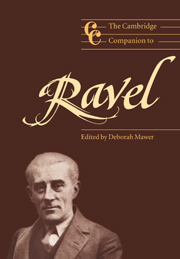Introduction
Published online by Cambridge University Press: 28 September 2011
Summary
The many masks of Ravel
Our image of Maurice Ravel is still partly obscured by mystery and intangibility, and by some lingering misunderstandings. This situation arises as a result of various factors: Ravel's own actions, his elusive blend of French, Basque and Spanish traits and the quirks of reception across the years (for instance, the emphasis on his undoubted skills of orchestration has to some extent down-played the actual substance of much of his orchestral music). Even in his lifetime, an interviewer for De Telegraaf exclaimed, literally and figuratively: ‘It is not easy to find the hiding place of Maurice Ravel.’
How then might we think about Ravel? He himself sometimes adopted the metaphor of masks, so popular in contemporary dramatic and balletic productions. Castigating the self-conscious academicism of Georges Witkowski, a pupil of d'Indy, he declared: ‘How far this repulsive intellectual logic is from sensibility! Nevertheless, behind this dour mask, one discerns a profound, vibrant musician at every moment.’ Among Ravel's early biographers, Vladimir Jankélévitch, especially, developed this image of masks in relation to the composer's compositional aesthetic: ‘Ravel is friend to trompe-l'œil, deceptions, merry-go-round horses and booby-traps; Ravel is masked.’
So what is the nature of the masks, or distorting mirrors, behind which we might seek Ravel? (In posing this question, we're aware of the impossibility of the quest: in peeling off one mask there is invariably another beneath; furthermore, the masks are so bound up with Ravel's identity that, at one level, they are part of him. No mask: no Ravel.)
- Type
- Chapter
- Information
- The Cambridge Companion to Ravel , pp. 1 - 4Publisher: Cambridge University PressPrint publication year: 2000



